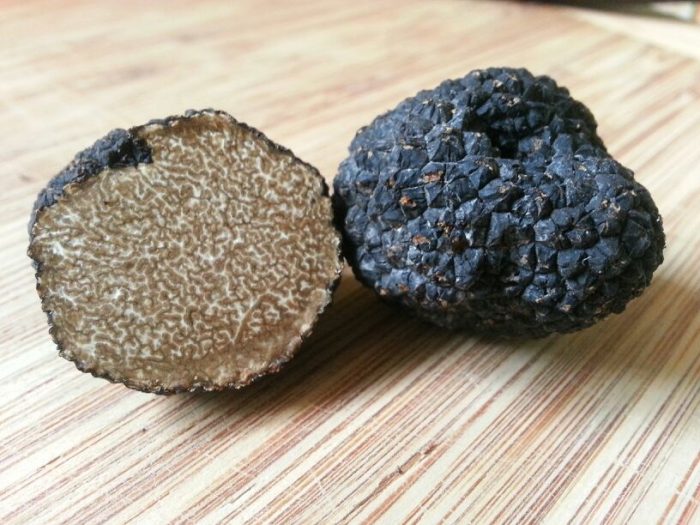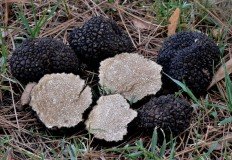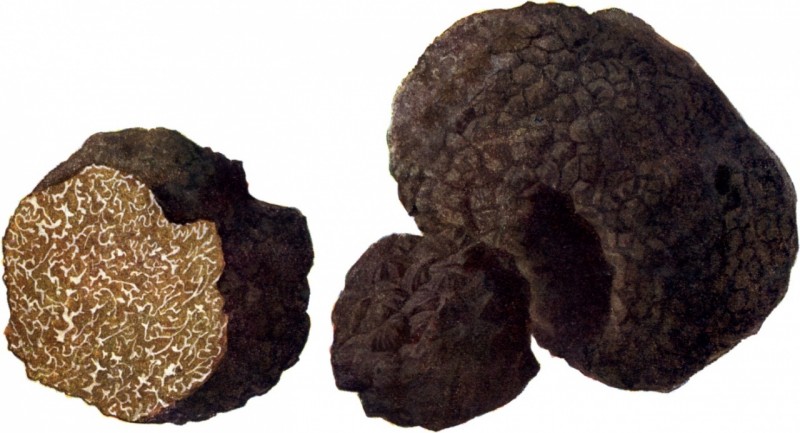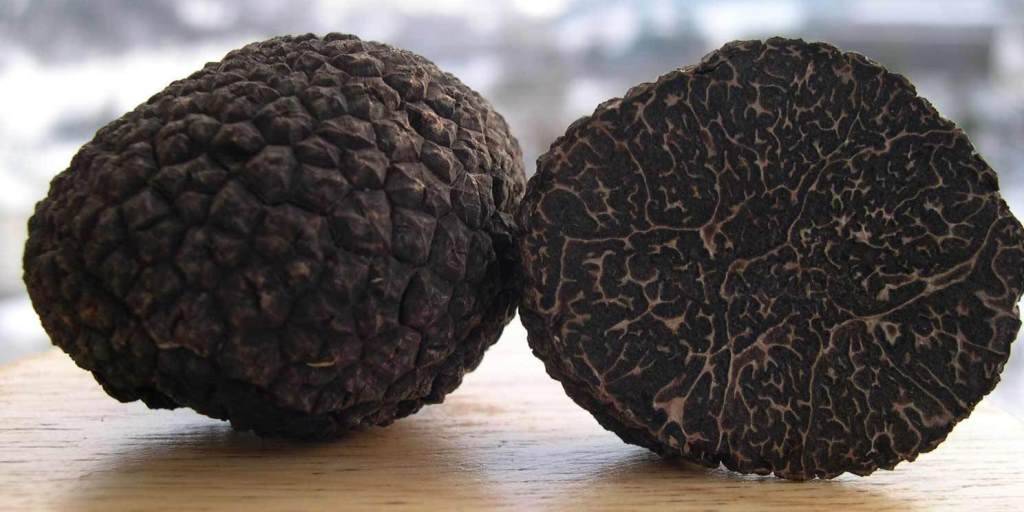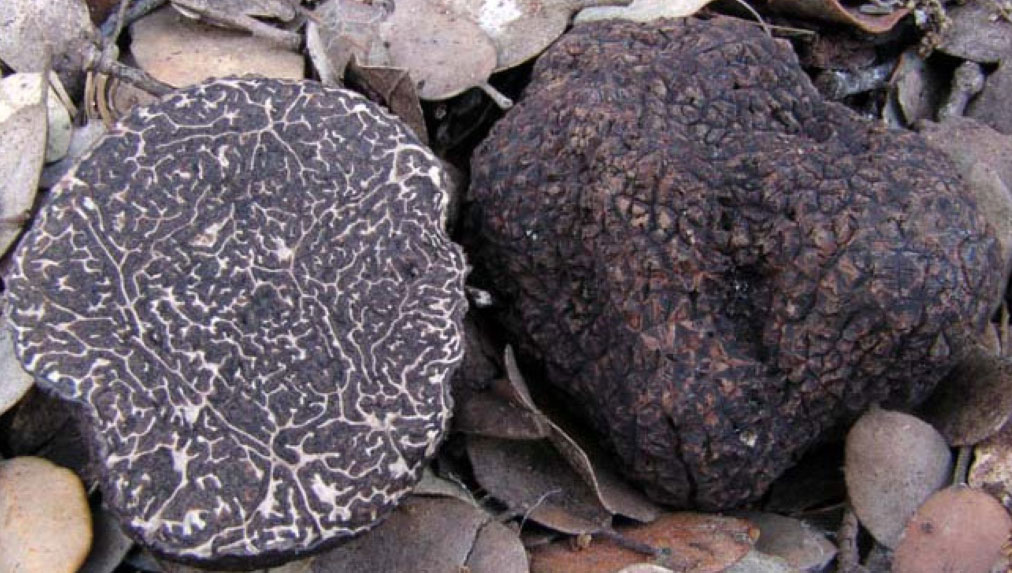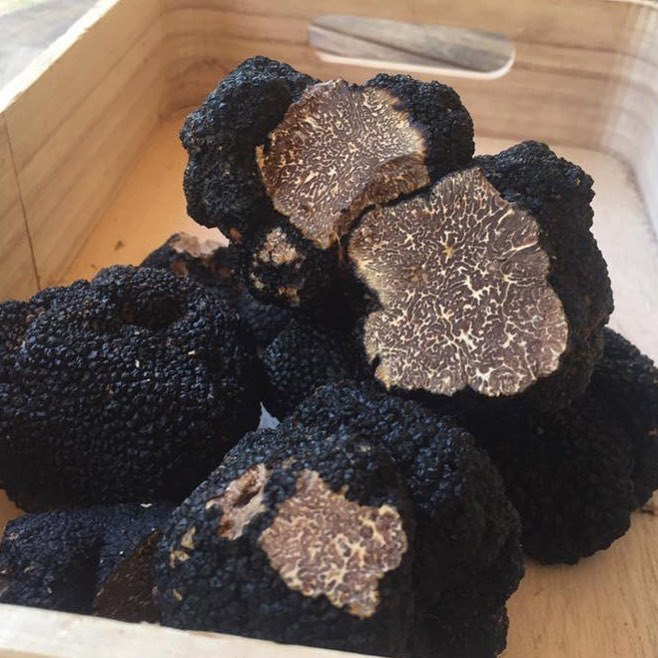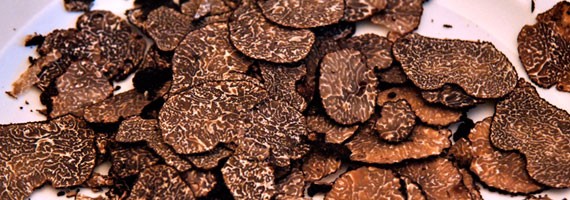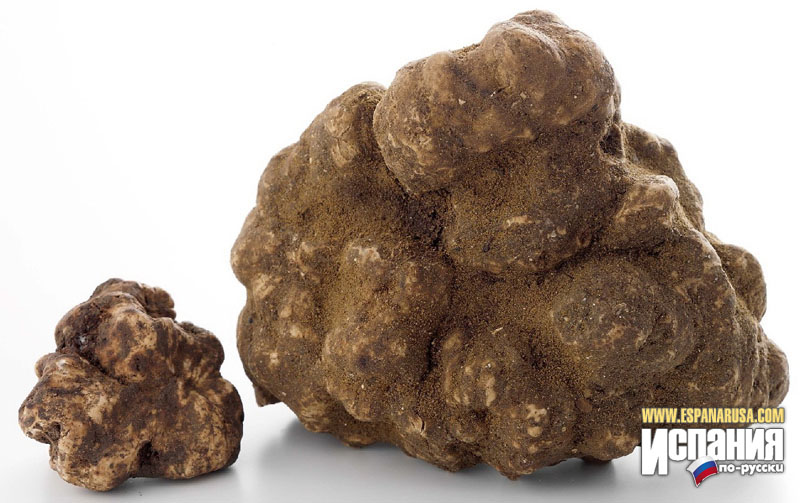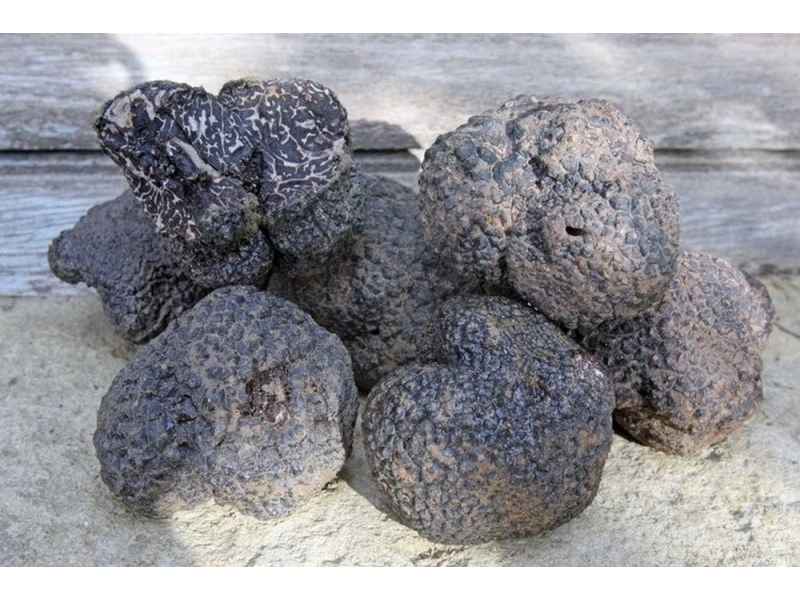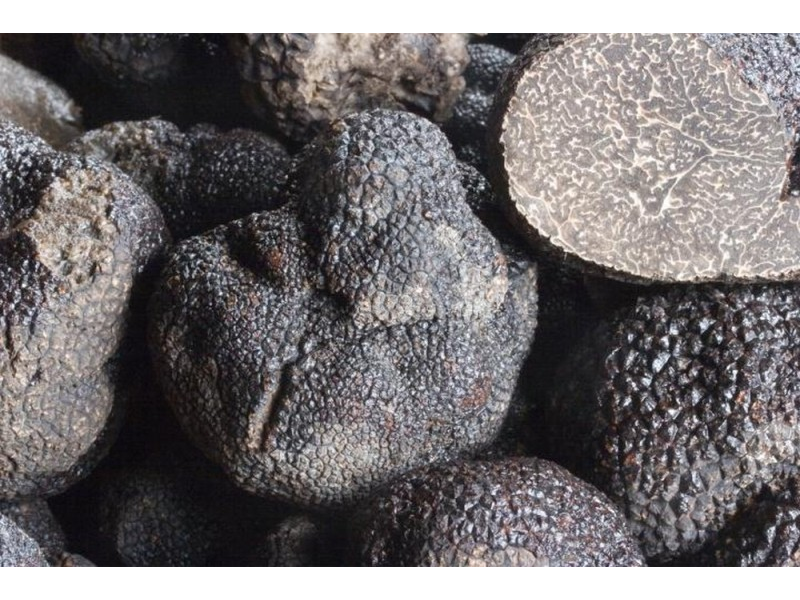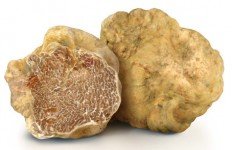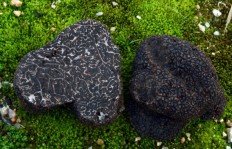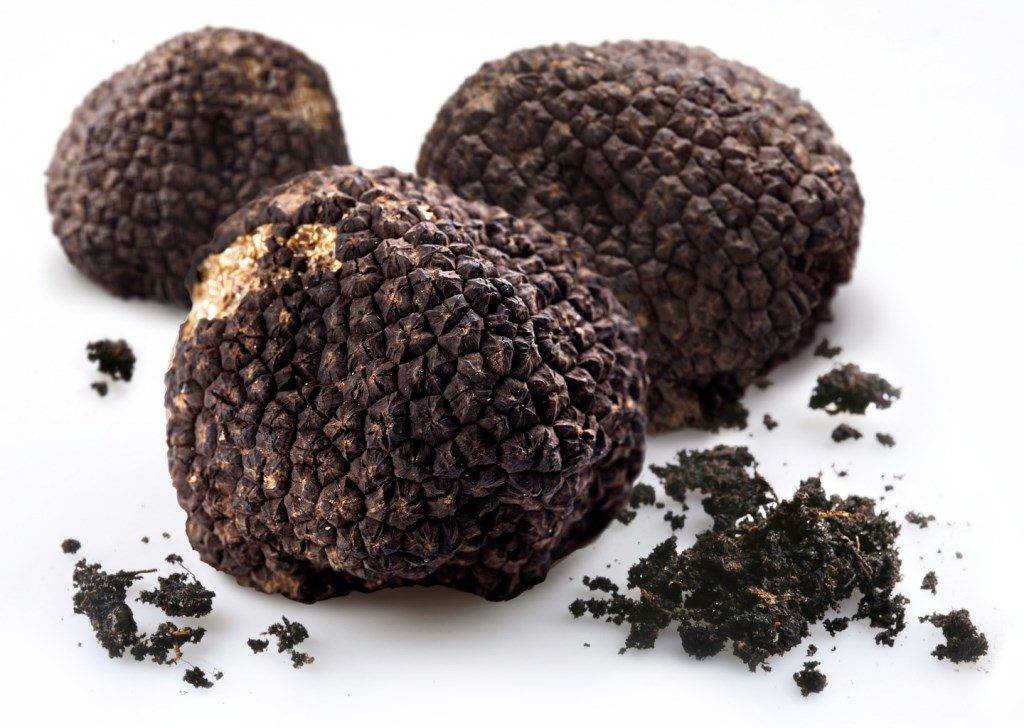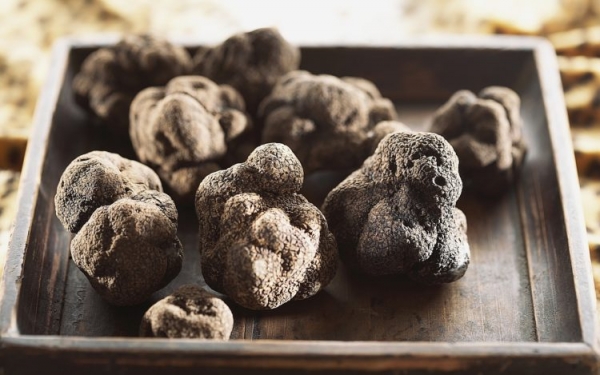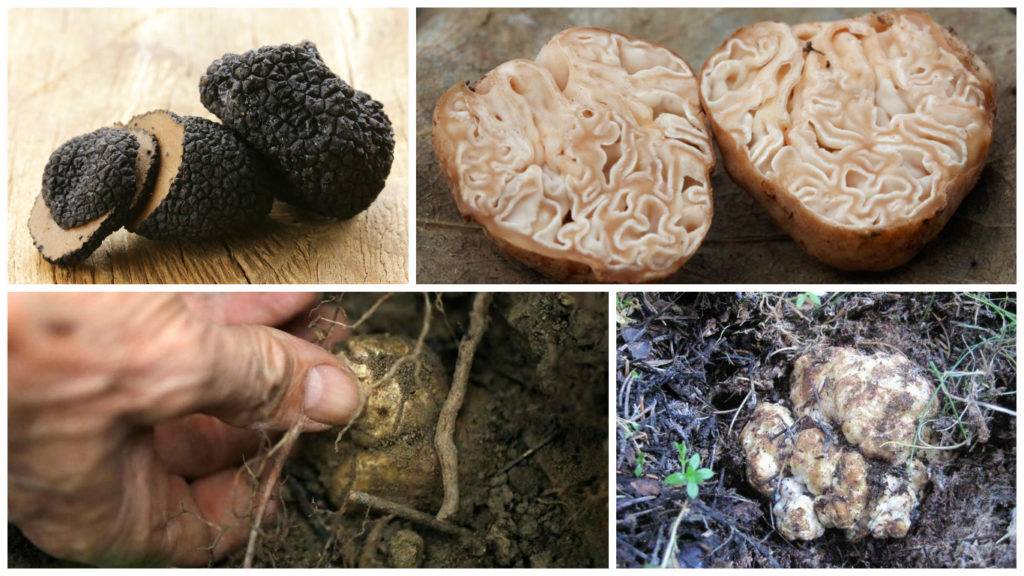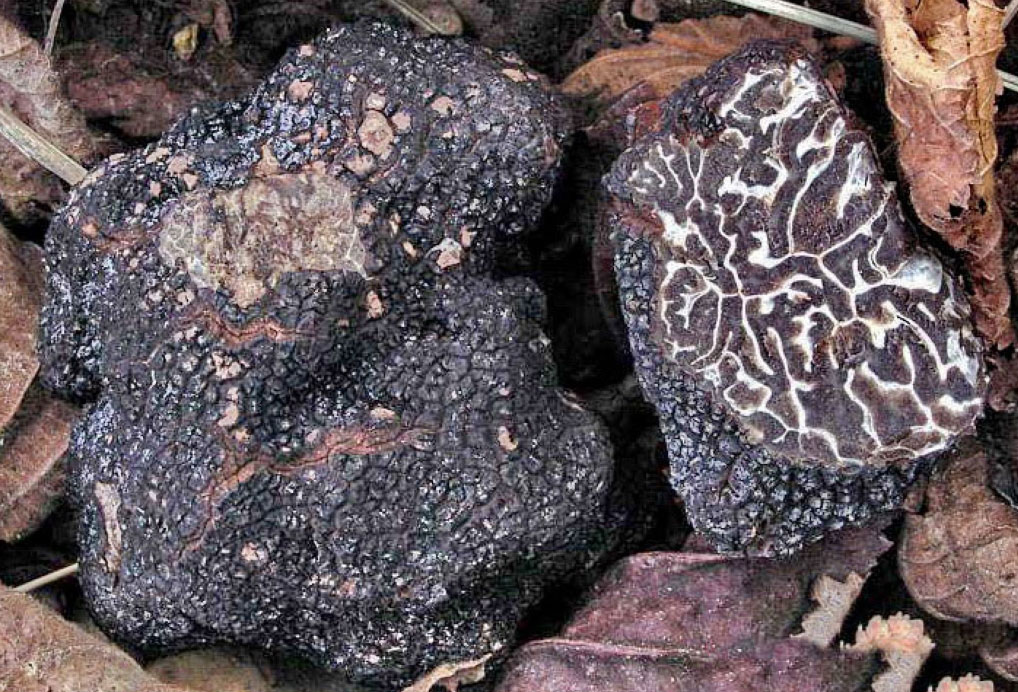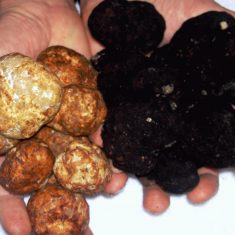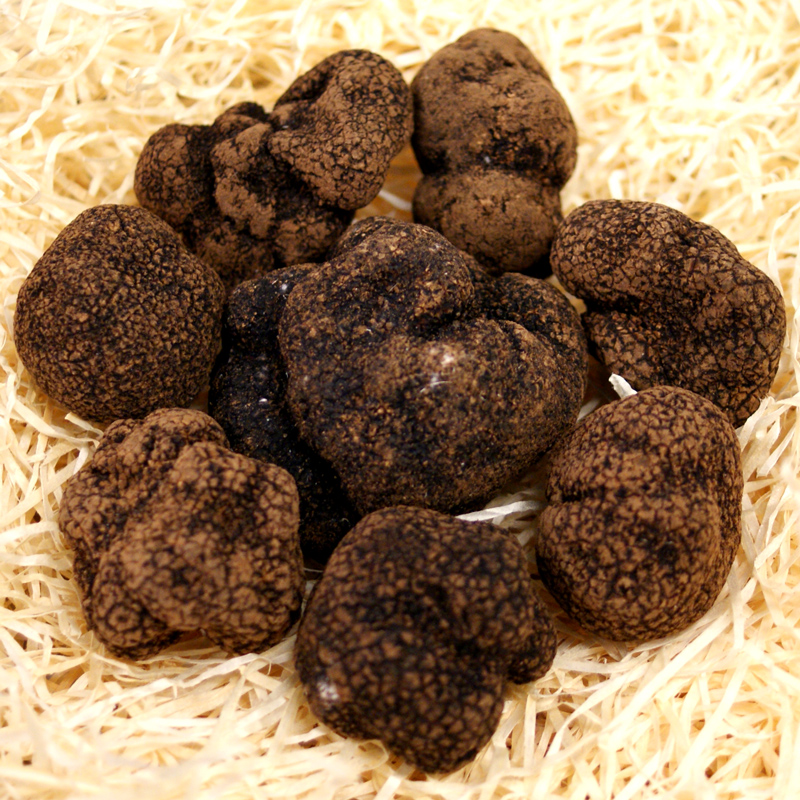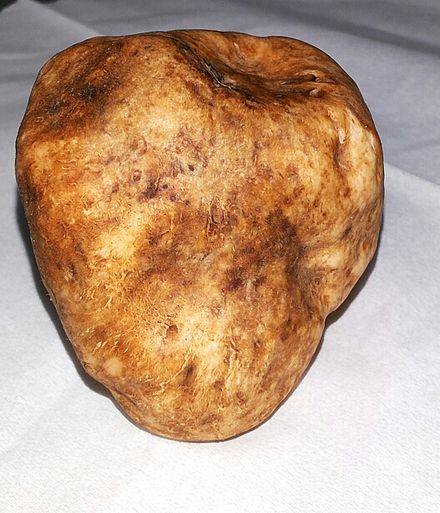Description of the mushroom
Black truffle (Tuber melanosporum) belongs to the Truffle family and Truffle genus. The mushroom is also called Perigord truffle, or black French. This revised name is due to the fact that most of the range falls on the French region of Perigord. This type is the most sophisticated and expensive.
Appearance
The mushroom has an external form of a tuber disproportionate in its structure. The body has 4 to 6 faces. The diameter of the tuber is 7-8 cm. The weight of one mushroom is up to 400 g. The color of the surface of the fruiting body depends on age. Young truffle is dark brown in color. Over time, the top layer turns charcoal black. If you press on the surface of the body, the color will turn dark orange.
The pulp is light, darkens over time from ripening spores and acquires a purple hue. The structure of the body is marble, with many white or light pink veins. The taste of the pulp is intense, characteristic with a chocolate note and light bitterness. The aroma is pronounced.
Microscopically small spores are oval or fusiform, strongly curved. The color of the spore powder is dark brown. Fruiting of the species lasts from early December to mid-March.
Places of growth
The Perigord black truffle grows not only in Perigord. Mushrooms of this species are found in other regions of France:
- Dordogne;
- Vaucluse;
- Gironde.
The species is also found in the north of Spain and Italy. China is the world's leader in the number of artificially grown black truffles. The Chinese counterpart is more common due to its low price. However, the quality of such mushrooms is significantly inferior to French ones.
Similar species
Besides the classic black truffle, there are other varieties with similar characteristics:
- Russian summer black truffle (Tuber aestivum): the fruit body reaches 12 cm in diameter, the mass of the mushroom is up to 450 g. With age, the color of the pulp changes from white to gray-brown. The taste gives off nuts. Places of growth - Crimea, the Caucasus, the European part of Russia. The species grows under pine and oak trees. The fruiting period is from June to mid-October.
- Black Burgundy truffle (Tuber mesentericum): this species is characterized by a rounded shape and weights up to 310 g. The diameter of the fruit body is up to 9 cm. The pulp has a light brown tint with a marble structure. The aroma contains notes of cocoa.
- Black winter truffle (Tuber brumale): rounded fruiting body, 7-20 cm in diameter. The mass of the mushroom reaches 120 g. The surface of the body has a purple hue and is covered with growths. The aroma is musky, pronounced. The fruiting period occurs in early November - mid February. Requires hazel or linden for growth. Growing places - Italy, Ukraine and southwest Switzerland.
- Himalayan black truffle (Tuber himalayensis): fruiting body usually weighing up to 50 g, with a pronounced nutty flavor. Finding tubers is difficult due to their small size.
Growth features
The mushroom grows at a depth of 35 cm
Truffle belongs to marsupial mushrooms. Such species have the following growth characteristics:
- The edible body is in the ground, at a depth of 10 to 35 cm.
- The soil for growth must contain lime in its composition.
- Certain tree species are essential for the good development of a truffle.
The black truffle species needs hazel or oak roots to form mycorrhiza. Other trees are not suitable for proper development.
The tree provides the truffle with the necessary complex of minerals, and the mycelium enhances the ability of the root system to absorb water and salt.
What is the difference between black truffles and white truffles?
Chefs use black truffles as one of the ingredients in the dish, white truffles serve as a condiment. This means that black truffles are added during the cooking process (preferably towards the end), their flavor is enhanced in the oil and with a little heat.
White truffle smells:
- strong;
- pleasant;
- intensive.
Unlike black truffles, which are prized for their taste, white truffles are used for flavor. White truffles are sensitive to heat and lose their aroma when cooked. White truffles are almost exclusively consumed raw and add to the flavor of the dish.
What a false truffle looks like
To date, many types of truffles have been established that can be safely eaten without danger to health. However, there are many other fungi that, if ingested, can cause digestive tract upset or severe intoxication (Figure 7).
It is very easy to mistake a false truffle for a real culinary rarity. They may have external similarities, but at the same time they belong to a different family. For example, deer grows in the wooded areas of Europe and North America and it is not edible for humans, but animals eat it with great pleasure.
 Figure 7. Appearance and features of a false truffle
Figure 7. Appearance and features of a false truffle
Reindeer truffle can cause stomach upset, but at the same time, false truffle is deadly to human health. Outwardly, it has an oblong shape, dark red or beige in color and belongs to the Basidiomycete family. The fruiting body of a poisonous mushroom can grow up to 10 cm in length and will have a characteristic unpleasant odor. The inedible species include tombolans (steppe truffles), which grow in Azerbaijan, Turkmenistan, North Africa and southern Europe. However, among the tombolans there are also edible mushrooms.
Truffle (Latin Tuber) is a genus of mushrooms of the Truffle family (Latin Tuberaceae), which is part of the Pezizales order. This genus includes edible species that are considered valuable delicacies.
Other mushrooms with similar fruiting bodies (for example, from the genera Choiromyces, Elaphomyces and Terfezia) are often called "truffles". Among them, there are also edibles, which sometimes go on sale as a "fake delicacy", but are valued significantly lower than mushrooms from the Tuber genus (referred to in this case as "real truffles").
Literature
- Mushrooms: Handbook / Per. with ital. F. Dvin. - M.: Astrel, AST, 2001 .-- 384 p. - ISBN 5-17-009961-4 .. - S. 280-281.
- Zheleznov N.I. On the distribution of white truffle in Russia // Bulletin of the Society of Gardeners. - 1883.
- Plant life. Encyclopedia in 6 volumes. T. 2: Mushrooms / Ch. ed. A. A. Fedorov. - M.: Education, 1976 .-- 479 p.
- - S. 30-33.
- Lesso T. Mushrooms: Key / Per. from English L. V. Garibova, S. N. Lekomtseva. - M.: Astrel, AST, 2003 .-- 304 p. - ISBN 5-17-020333-0 .. - S. 258-259.
- Udu J. Mushrooms: Encyclopedia = Le grand livre des Champignons / Per. with fr. - M.: Astrel, AST, 2003 .-- 191 p. - ISBN 5-271-05827-1 .. - S. 170-171.
Mushroom truffle - what does it look like and where does it grow?
Truffle is a rare delicacy mushroom that grows underground. On the market, 1 kg of such mushrooms costs from 2 to 5 thousand euros, some specimens were sold at a higher price. The high cost is determined by the complexity of obtaining the mushroom and high demand. High demand due to its extraordinary taste, which will be appreciated even by a strict critic.
Mushrooms grow in hard-to-reach places, 10-15 cm underground under the roots of trees, which complicates their search. The location of the mushrooms depends on the composition of the soil and climate. You need to look for them in the roots of poplar, linden, rowan, oak, beech, birch, from this we can conclude that the mushroom chooses mixed and deciduous forests.
What is a mushroom
Truffle is a parasite fungus, it develops on the roots of trees and draws useful microelements from them, it does no harm. Another difficulty in finding mushrooms is that there are different types of truffles and each type ripens at a certain time, for example: white in autumn, black in winter.
Truffles grow in Europe, North America, Asia and the USA. In Russia, truffles are found in places where a warm climate prevails, sometimes they can be found in the European part, mainly where the soil is saturated with lime.
Basically, truffles are divided into 2 types: these are black and white types.
- Black truffle. It begins to ripen in the summer and bears fruit by the fall. Fresh fruit is red-purple in color, sweat. The core is white. They grow under the roots of oak, hornbeam, beech, sometimes near pines and birches.
- White truffle. Ripens from autumn to early winter. The fruits are yellowish in color, the flesh itself is white.It is less common than black truffle, therefore it is more appreciated.
Where does the mushroom grow?
The geography of the truffle habitat in Russia is quite extensive, it is found in the Central regions, in the Volga region, in the Caucasus.
European part
In deciduous and mixed forests in the Caucasus, on the Black Sea coast, in the Moscow, Voronezh, Podolsk, Tver, Leningrad regions, you can find a black truffle. White tubers are found in the Tula, Oryol, Vladimir, Smolensk, Kuibyshev regions.
Siberia
Deciduous and coniferous forests of Siberia are the habitat of the delicious white truffle, and favorable climatic conditions contribute to their good harvest.
Crimea and Caucasus
Mild climatic conditions and planting of oak and beech groves increases the yield of mushrooms and promotes their active growth. Gelendzhik, Anapa, the village of Abrau-Dyurso, Alania are the regions that account for the largest amount of the harvest.
Due to the complexity of mushroom picking, there is a whole set of rules, thanks to which the picking efficiency can be increased many times over.
The most important thing is to choose the right forest. These should be areas with deciduous trees (beech, birch, oak)
The soil should contain a large amount of lime and sand. In the mushroom place there will be high humidity, the vegetation is stunted, the earth is gray-ashy, and midges will circle over the place. If the plantings are very young, then you won't be able to find mushrooms there, but you can often see traces of wild boars and other animals around.
You should pay attention to the bumps under the trees and look for places where the roots are large. The main condition for finding mushrooms is the availability of trained assistants.
It can be a dog or a trained pig. Animals can smell the delicacy up to 25 meters away. As soon as the beast starts digging the ground, you need to immediately stop it before it ate or spoiled the mushroom. All truffle places can be memorized and returned there, while it is advisable to search everything nearby, because there is a chance to find a new habitat for this wonderful mushroom.
What a truffle looks like
If you want to find these mushrooms in the forest, you definitely need to know what a truffle looks like (Figure 4). Outwardly, the shape of the fruit bodies can be tuberous or rounded with a size of 2-10 cm. Peridium has a dark color range from bluish-black to brown-black. On the surface, pyramidal warts can very often be observed, but there are species with a smooth peridium.
Figure 4. External features of truffles
The flesh of a mature specimen is loose, and a young one is dense. At the very beginning of growth, the flesh will be white and, as the specimen matures, it will acquire a brownish-yellow color. When cut, the light streaks give it a marbled color. The pulp is sweetish in taste and similar to a nut, and the aroma is similar to the smell of algae.
What a truffle looks like and where to find it - the author of the video will tell you.
The main differences from other mushrooms
Truffles on the market are very expensive and the price for 1 kilogram of such a rare product starts from 400 euros. Such a high cost of this type is associated with the following factors:
- The difficulty of growing;
- Seasonal loot;
- High level of taste and aroma properties (quality) of the product.
The value of each unit is measured by its size: the larger the copy, the more expensive it costs. The most expensive are mushrooms with a large fruiting body (like an apple), but less than 1% of the total world harvest of such specimens grows. Walnut-sized specimens make up 10% of the crop, and grape-sized specimens make up 30%. The rest of the percentage is made up of very small mushrooms, and their cost is much less. The very small ones are mainly used for making a variety of sauces.
Timeline ‹Our cuisine‹ White truffle, Italian (Tuber magnatum)
Posted on 16 Sep 2018 12:54 pm, Last modified 24 Sep 2018 12:50 pm
Order: Pezizales; Family: Truffle (Tuberaceae); Genus: Truffle (Tuber); Species and synonyms: Truffle white, Italian, real, Piedmontese (Tuber magnatum, Rhizopogon magnatus, Choiromyces gangliodes f. Magnatum). The most rare, and therefore the most expensive kind of truffle. Experienced mushroom pickers know the right signs of how to find these underground treasures. For example, dry soil around a tree can serve as a sign - this is the result of the influence of an underground mycelium. A reliable remedy is the delicate smell of mushrooms, it is invisible to humans, but flies feel it and accumulate in places where truffles grow. Truffle hunting is a complex process that requires painstaking preparation. These mushrooms grow one by one, so you have to spend a lot of time for each specimen found. It is very difficult to move the mushroom away from the tree, since their flesh is very delicate and easily damaged. White truffles appear in October, and according to tradition, a truffle fair is held in Piedmont at this time. This delicacy can be bought at the fair in any form: fresh, canned, dried. Locals call truffles “diamond mushrooms” and “white gold”, and this is justified, because their cost is simply fabulous - up to 8 thousand dollars per kilogram. The yield of Italian truffles changes from year to year, it is impossible to predict it. In years of poor yields, the price of these delicacies can rise significantly. In addition, these mushrooms have a very short fruiting season. In Italy, the search for truffles begins in November. The most expensive, naturally, are fresh truffles. Even many restaurants prepare a special menu during the truffle season. Many people try to grow truffles artificially, and the Chinese manage to do it with black truffles. Although “Chinese black truffle” and “poor quality product” are synonymous, they have their own customers due to their low price. But no one has yet managed to grow white truffles artificially. Truffles have a short shelf life, they are not stored in pure form, but in sauces or oil. Therefore, connoisseurs of Italian truffles manage to taste this delicacy exclusively during the hunting season, and then they spoil. Restaurateurs buy up these mushrooms literally in a matter of days. Fruit body: (modified apothecia) underground, in the form of irregular tubers, usually 2-12 cm in size and weighing 30-300 g. Occasionally there are specimens weighing 1 kg or more. The surface is uneven, covered with a thin velvety skin that does not separate from the pulp, light ocher or brownish in color. The pulp is firm, whitish to yellow-gray in color, sometimes with a reddish tint, with a white and creamy brown marble pattern. The taste is pleasant, the smell is spicy, reminiscent of cheese with garlic. Spore powder, yellowish-brown, spores 40 × 35 microns, oval, reticulate Habitat: forms mycorrhiza with oak, willow and poplar, also found under lindens. Grows in deciduous forests with loose calcareous soil at varying depths. Most common in northwestern Italy (Piedmont) and adjacent regions of France, found in Central Italy, Central and Southern France and other areas of southern Europe. Fruiting period: the collection of the white Piedmont truffle officially begins on September 21st and ends on January 31st. These mushrooms are harvested, only with the help of trained dogs, pigs in Italy for collecting truffles are prohibited. Edible: it is not just an edible mushroom, it is a delicacy. In Italian cuisine, these mushrooms are almost always used raw. They are grated on a special grater and added to sauces or used as a seasoning for various dishes, for example, risotto, salads, scrambled eggs, and so on. Also, seafood, veal, grilled meat are cooked with these mushrooms. The most important thing about truffles is their unique aroma, which becomes even stronger when cooked. This white truffle has light notes of pepper, garlic and honey.Italian truffles taste softer and more refined than black French truffles. They contain more gaseous substances that are released when the pulp is pressed. In the Middle Ages, these mushrooms were harvested in hundreds of tons per season, then they were simply boiled in wine and served as a snack. Gourmets around the world agree that the taste of fresh white truffles is incomparable to other products.
Taste qualities of black French truffles
The strong aroma of these mushrooms is highly prized by gourmets. Some connoisseurs say that black truffles smell like chocolate, while others smell of forest dampness with a hint of alcohol.
The mushrooms are cut, or, as the professionals say, shave with a special spatula with a sharp blade, resulting in translucent pieces. Various dishes are sprinkled with black truffles: fish, meat, pizza, vegetables, soups, risotto. These mushrooms give a unique aroma to all dishes and go well with all dishes.
Gourmet chefs go further and use this delicacy as an ingredient in desserts, such as truffle ice cream or treats made from egg whites, almonds and black truffles.
From the history
The finds in Mesopotamia indicate that people have been eating these mushrooms for 4 thousand years. Without black truffles, not a single Greek feast took place; Emperor Augustus adored them.

On January 17, the feast of St. Anthony is celebrated, it is believed that it was this saint who found black truffles with the help of a pig and his staff.
Charles V, King of France, always had black truffles on his table, which were considered a popular aphrodisiac. The wife of Louis XV gave birth to ten children, while she ate huge quantities of truffles. Napoleon, who had no children, asked one officer with many children what his secret was, and he said that he was born in Sarles, the capital of truffles, and he always ate plenty of them. Later, the emperor had an heir.
In the twentieth century, the number of truffles decreased significantly, which was associated with the past two wars. Only in the 60s did the situation begin to stabilize. But even today the extraction of truffles does not reach the scale of the 19th century.

Truffle legends
Due to the fact that truffles grow underground and spontaneously appear, many myths and legends have emerged about these mushrooms. Previously, it was believed that lightning gave birth to truffles, that they are a gift from the gods with a heady smell.
According to one legend, a lumberjack from Perigord shared his potato with a hungry old woman. And the old woman turned out to be a fairy and rewarded the woodcutter with the fact that truffles grew in his garden. The woodcutter and his family got rich. When the man died, his children became rich, but they turned out to be not as noble as their father, when the old woman returned to them, they refused her alms. Then she made it so that all the truffles disappeared in their garden, and turned them into pigs themselves, so that they would be doomed to serve the owners and look for these mushrooms.
Varieties of truffles
• Sand truffle is found in Turkey, Saudi Arabia and North Africa. But in France it is forbidden to sell them under the name of a truffle;
• White truffle or garlic truffle tastes like cheese with garlic and shallots. It grows in Italy;
• The gray truffle is harvested in Champagne and Burgundy. It is also called musk truffle;

• Black autumn truffle grows in Germany, England, Normandy and Czech Republic. This mushroom has a bitter taste and is not of such high gastronomic interest as the black truffle;
• The March White Truffle is native to Italy. It is called the "poor white truffle";
• Black winter truffle ranks second in taste after black truffle. It grows in southern and central Europe;
• The Chinese truffle is native to the southwest of China.
Artificial mushroom cultivation
In its natural environment, the truffle is distributed thanks to the forest animals that feed on it. Together with feces, the spores fall to the ground near the roots of trees, where they successfully take root.However, in many countries, artificial cultivation of such mushrooms is practiced. Mostly these are black species.
To breed a truffle mushroom, the following factors must be considered:
- temperate climate;
- suitable types of trees;
- unique soil composition.
To achieve this goal, artificial green massifs of oak trees are created. In some cases, the roots of young seedlings are specially infected with truffle spores so that they can successfully develop on them. As you can see, the process of growing an exotic product requires a lot of time and effort. Therefore, only experienced specialists are engaged in this business.
The composition of the mushroom includes many useful elements that help strengthen the human body. By taking it for food, even occasionally, you can forget about emotional disorders and other illnesses for a long time. It is practically harmless and does not cause food allergies.
Cooking features
It is necessary to be able to properly prepare truffle dishes, because spoiling such an expensive ingredient will be very disappointing. This mushroom goes very well with various fruits, as well as ham, veal and cheeses, making it possible to prepare delicious and unusual dishes, including pakery with foie gras, aspic with foie gras and the famous turkey with truffles in many cuisines of the world. The famous Strasbourg pie is also filled with these mushrooms.

Truffle sauce
Ideal for pasta, potato, meat dishes, as well as sea and river fish or vegetables.
Ingredients for cooking:
- medium-sized black truffle;
- a quarter cup of white truffle oil;
- ½ cup heavy cream;
- a glass of white wine;
- a teaspoon of minced garlic;
- a tablespoon of chopped shallots;
- 0.2 kg of butter;
- a pinch of white pepper;
- chives;
- salt to taste.

Stir truffle and butter, shape into a square and leave in the freezer for a few minutes. Stir in garlic, shallots and white wine, then add pepper and salt, then simmer in a saucepan for 2-3 minutes. Add cream and boil for a couple of minutes. Cut the frozen butter into medium-sized cubes and add to the sauce. After dissolving the oil, cool the sauce and add chopped black truffle and chives.
Istrian fuji with truffles
A classic and very popular Croatian dish with mushrooms.
Ingredients for cooking:
- 0.35 g flour;
- a tablespoon of refined vegetable oil;
- a couple of eggs;
- a couple of tablespoons of white wine;
- salt;
- 0.1 kg of truffles;
- 0.1 kg of dried or smoked ham;
- 0.1 kg of parmesan;
- butter;
- fresh herbs;
- salt and spices.
Add eggs to the flour passed through a sieve and pour in refined vegetable oil, and then wine, add a little water and a pinch of salt, and then knead a sufficiently thick dough. Roll out in a sufficiently thin layer and cut into 5 x 5 cm squares. Connect the opposite corners of the squares and, dropping them into boiling water, boil until tender. Drain and add butter.

To make the mushroom sauce, fry the truffle and small pieces of ham in slices over medium heat with the addition of butter, main spices and salt. At the final stage, pour in a small amount of broth and boil for a few minutes. Season with mushroom fuji sauce, sprinkle with chopped herbs and grated Parmesan.
Types of mushroom truffle
Summer truffle (Tuber aestivum)
The fruit body is underground, tuberous or rounded, 2.5-10 cm in diameter. The surface is brown-black or bluish-black, covered with black warts. The flesh of a young mushroom is dense, becomes friable over time, the color changes from whitish to brown-yellow and gray-brown, light veins form a marble pattern. The taste is nutty, sweetish, the aroma is pleasant and strong.
It is found in mixed and deciduous forests, on calcareous soils, under oak, beech, hornbeam, birch, in Central Europe, in Russia.The fruiting season begins in summer and lasts until early autumn.
Winter truffle (Tuber brumale)
The fruit body is irregularly spherical to almost round, 8-15 cm in diameter. The weight of an adult mushroom is 1-1.5 kg. The surface is covered with warts, 2-3 mm in size. The color of a young mushroom is reddish-purple, turns black with age. The pulp is white at first, then becomes gray or gray-violet with white and yellowish-brown marble veins. Has a strong and pleasant scent reminiscent of musk.
Grows in France, Italy, Switzerland, Ukraine. Ripens from November to February-March.
Italian truffle (Tuber magnatum)
The fruit body is underground, has the shape of irregular tubers measuring 2-12 cm and weighing 30-300 g. The surface is uneven, velvety, light buffy or brownish, the skin does not separate from the pulp. The pulp is firm, whitish or yellow-gray, sometimes reddish, with a white and creamy brown marble pattern. The taste is pleasant, the smell is spicy, similar to cheese with garlic.
Mycorrhizal forming agent with oak, willow and poplar, lindens. Found in deciduous forests in northwestern Italy (Piedmont), France. The collection of the white Piedmont truffle lasts from 21 September to 31 January.
Black truffle, or Perigor (Tuber melanosporum)
The fruit body is underground, tuberous, round or irregular in shape, 3-9 cm in diameter. The surface is reddish-brown, in old mushrooms it is coal-black, and becomes rusty when pressed. The flesh is firm, light, gray or pinkish-brown in color with a white or reddish marbled pattern, in old mushrooms it is dark. It has a strong characteristic aroma and pleasant taste with slight bitterness.
Grows in deciduous forests, on calcareous soil, most often under oak trees. Distributed in France, Italy and Spain. The season runs from November to March.
Choosing wine for truffles
Truffle is considered a gourmet delicacy and the most expensive mushroom in the world. The fruiting bodies of truffles are deep underground and are characterized by a round or tuberous shape. Mushrooms form mycorrhiza with tree roots. Truffles come in over a hundred varieties. Conventionally, they can be divided into black, which are more common, and white, more rare and therefore more valuable.
They grow in countries with warm, temperate climates. Their production is widespread in France, Germany, Spain, Italy, Portugal. The most valuable and expensive are black truffles, which are obtained in Perigord in France, and white ones, which grow in Piedmont and Umbria in Italy. Many are interested in the question: where does it grow mushroom truffle in Russia?
Where does white truffle grow in Russia?
This type of truffle is rare and therefore very valuable. In Russia, it grows in the average Volga region, Vladimir, Moscow, Smolensk, Tula, Oryol regions. White truffles grow from late autumn to early winter.
The size of the mushroom is up to 15 cm, weight - up to 500 g, in the soil it is at a shallow depth - up to 15 cm. Externally, a white truffle looks like it, it has a brown skin and light pulp. The truffle has a more meaty than mushroom flavor and a pronounced aroma.
Where does black truffle grow in Russia?
The black truffle that can be found in Russia is called summer truffle. Where does summer truffle grow in Russia? Its location can be called the Caucasus on the Black Sea coast. He prefers calcareous soils for growth. Its size reaches 10 cm, it grows in the ground at a depth of 10-15 cm. This type of truffle is harvested in late summer - early autumn.
In which forests do truffles grow in Russia?
The truffle mushroom prefers to grow near the roots of such trees: oak, birch, hornbeam, beech, walnut. Accordingly, they can be collected in forests where these types of trees are found. The greatest probability that the truffle mushroom grows in Russia in oak forests.
Propagation of truffles in nature
In nature, truffles do not reproduce in the same way as other mushrooms, in which spores are carried by wind or water. The only way the seeds (mycelium) of a truffle are spread is through animals.Since the seeds are deep underground, animals carry them when they search for mushrooms.
Truffle harvesting methods
Specially trained animals - pigs or dogs - are used to search for truffles. This is considered a real hunt, which takes place at night, as the smell of truffles is better heard at night. You can try to find mushrooms by looking at the numerous swarms of midges above the ground. If one truffle is found, then another 5-6 mushrooms will appear next to it. Collecting truffles is a very complex process. They must be dug up and collected very carefully, trying not to damage both the mushrooms themselves and the roots of the tree near which they grow.
Growing truffles
Growing truffles on artificially created plantations is a very laborious process that takes a lot of time. First, acorns are harvested from under the oak trees, next to which the truffles grew. Then a special soil is prepared: they mix the soil suitable for and the soil taken from the places where the mushrooms grew. Then prepared acorns are planted in this soil. Thus, young trees grow in soil containing truffle spores.
The first harvest is obtained in 6 years. You can harvest mushroom crops for 25-30 years. They will amount to 15 kg of truffles per hectare of land.
In Russia, truffle growing technologies are not widespread, this process is typical for other countries.
Truffles are a real delicacy. The cost of one kilogram of such mushrooms is estimated at thousands of dollars. You can try dishes from them in restaurants. How is truffle collection done?

